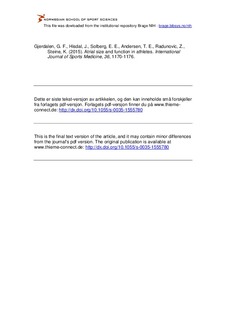| dc.contributor.author | Gjerdalen, G. F. | |
| dc.contributor.author | Hisdal, Jonny | |
| dc.contributor.author | Solberg, E. E. | |
| dc.contributor.author | Andersen, Thor Einar | |
| dc.contributor.author | Radunovic, Z. | |
| dc.contributor.author | Steine, K. | |
| dc.date.accessioned | 2016-10-04T12:38:33Z | |
| dc.date.available | 2016-10-04T12:38:33Z | |
| dc.date.issued | 2015 | |
| dc.identifier.citation | International Journal of Sports Medicine. 2015, 36, 1170-1176 | nb_NO |
| dc.identifier.uri | http://hdl.handle.net/11250/2412820 | |
| dc.description | Dette er siste tekst-versjon av artikkelen, og den kan inneholde små forskjeller fra forlagets pdf-versjon. Forlagets pdf-versjon finner du på www.thieme-connect.de /
This is the final text version of the article, and it may contain minor differences from the journal's pdf version. The original publication is available at www.thieme-connect.de | nb_NO |
| dc.description.abstract | We wanted to explore if change in LA size would influence LA function, or increase regurgitation in the atrioventricular valves. 595 male elite football players and 47 non-athletic controls were included. End-systolic LA volume and RA area and end-diastolic LV volume and RV area were measured by two-dimensional (2D) echo. Pulsed and colour Doppler were used to estimate tricuspid and mitral regurgitations. 2D longitudinal strain of the 50 football players with the largest LA volumes were compared with the 50 players with the smallest LA volumes. The LA volumes in some athletes were more than tripled, compared to athletes with small atria. 2D strain however, could not reveal any impairment of LA function in the players with the largest atria, compared to those with the smallest LA. Tricuspid valve regurgitation was found in 343 (58%) of the athletes, compared to 17 (36%) of the controls (p<0.01), while mitral regurgitation was found in 116 (20%) football players and seven (15%) controls (NS). Furthermore, the RA area was significantly larger in athletes with tricuspid regurgitation compared to athletes without. The present study demonstrated a huge variation in atrial size between the athletes. This variation, however, had no impact on LA function. Tricuspid regurgitation was significantly more prevalent among the athletes, than among the controls. | nb_NO |
| dc.language.iso | eng | nb_NO |
| dc.publisher | Thieme | nb_NO |
| dc.subject | athlete's heart | nb_NO |
| dc.subject | elite football players | nb_NO |
| dc.subject | right atrium | nb_NO |
| dc.subject | left atrium | nb_NO |
| dc.title | Atrial size and function in athletes | nb_NO |
| dc.type | Journal article | nb_NO |
| dc.type | Peer reviewed | nb_NO |
| dc.subject.nsi | VDP::Social science: 200::Social science in sports: 330::Other subjects within physical education: 339 | nb_NO |
| dc.source.journal | International Journal of Sports Medicine | nb_NO |
| dc.identifier.doi | 10.1055/s-0035-1555780 | |
| dc.description.localcode | Seksjon for idrettsmedisinske fag / Department of Sports Medicine | nb_NO |
